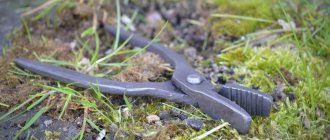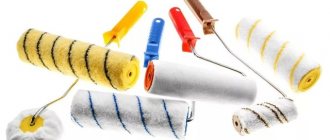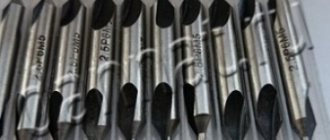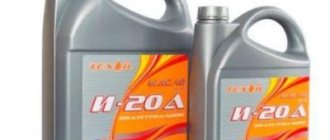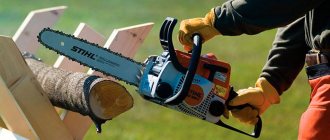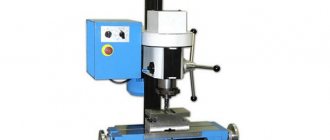Pincers and forceps are the most ancient devices known since prehistoric times. According to historians, they were initially used in blacksmithing, but very quickly formed a large group of pliers. Today, the number of varieties of such devices is very large; not every master can list them all at once. They are usually called pliers or pliers, although almost every design option has its own name.
It is noteworthy that significant changes in the design of such instruments have not been made for a very long time, despite noticeable changes in the appearance of other devices. In addition, the specific use does not imply the creation of a power tool from these devices. Let's take a closer look at them.
What are pliers and pliers?
1-Pliers 2-Pliers
Both types are the most common and extensive types of pliers. They all have a similar design - two identical (most often) elements connected by a hinge. On one side there are handles, the other part is the working part.
The difference between all types consists of two positions:
- Sponge shape . This indicator determines the name and purpose of the tool.
- Hinge type . The classic type is a fixed hinge, but detachable options are often found that allow you to change the size of the working base (the grip width of the jaws).
The purpose of the tool is determined by the shape of the jaws. It can have cutting edges, cutouts that provide a stronger and tighter grip, and form a kind of template for bending various parts.
The following varieties exist:
- Pliers.
- Pliers.
- Wire cutters.
- Side cutters.
- Round nose pliers.
- Long nose pliers.
- Needle nose pliers.
- Ticks.
Expert opinion
Levin Dmitry Konstantinovich
In everyday life, any type of tool at the disposal of a craftsman is often called pliers. This is wrong, but it is not important for a home master. However, when communicating between specialists or in a store, you should be precise and understand the differences between the tools.
What can we expect from Knipex in the future?
Every day our developers work on further effective innovations in collaboration with professionals and ordinary tool users. One of these innovations is the KNIPEX Cobra® XS 87 00 100 : with a length of just 100 mm, the “pocket” plumbing pliers are the most compact fully functional plumbing pliers in the world. TubiX® 90 31 02 pipe cutter has recently been developed almost from scratch , featuring the QuickLock one-handed adjustment system to make cutting copper, brass and steel pipes easier and more precise than ever!
Difference between pliers and pliers
The difference between both types is not fundamental, but quite definite.
Pliers are designed for gripping, squeezing, and bending various parts or workpieces. The working surfaces are straight, usually with fine corrugation to prevent the material from slipping when gripping.
Pliers are a universal tool. They are capable of performing a significantly larger number of operations and tasks, since their jaws are equipped with various recesses, grips, and cutting edges on both the inside and outside.
A typical set of functionality typical of pliers:
- Capturing, clamping parts.
- Bending wire or sheet metal.
- Biting wire, nails, screws, etc.
The versatility of pliers makes them the main type of pliers. They are used by electricians, mechanics, technicians, and other specialists. Due to their capabilities, they are included in the mandatory set of tools and devices required to perform most technical or construction tasks. Often pliers are equipped with additional tools - a grip on the other side of the hinge, auxiliary devices at the ends of the handles (screwdriver or awl). The demand and popularity of the instrument is confirmed by the large selection of manufacturers and models available on store shelves.
What are there
Such tools belong to the category of hand-held pliers. They are equipped with long handles and short jaws, the shape of which depends on the purpose of the device. The product is intended to perform the following technological operations:
- clamping;
- clamp;
- compression.
An irreplaceable thing when working with worn-out and damaged nuts. The built-in self-locking function prevents the edges from sliding off.
Pliers are suitable for working with different parts, so manufacturers produce products in different designs. Main scope of application:
- for plumbing and installation work;
- for plumbing manipulations;
- construction.
Based on their design features, the following types are distinguished:
- adjustable pliers;
- devices for crimping operations;
- devices for crimping cable lugs;
- welding clamping pliers;
- automatic devices;
- plumbing type pliers;
- end products with which nails are removed.
Plumber-type wrenches work with round, hex or square profiles.
Features, technical specifications
The main technical characteristics of pliers and pliers are:
- Size (total). Usually ranges from 10 to 20 cm.
- Width of jaws. standard - 2-3 cm.
- Opening angle of working surfaces. Depends on the type of hinge and specific design features.
- Set of functions (for pliers). The presence of cutting surfaces, the ability to cut through steel wire using a groove on the outer surface of the jaws, a return spring, etc.
- Hinge type. There are fixed or adjustable designs
- Availability of rubber, PVC or plastic linings for handles
- View
- Coatings: Tools are available in chrome or blued finish.
The main feature of the tool is the presence of two handles that perform dual functions:
- Used for holding in hands.
- Adjust the amount of opening and compression force of the jaws.
Expert opinion
Levin Dmitry Konstantinovich
Working with insulated handles allows you to protect yourself from electric shock and provides comfort when using the tool in severe frost. However, there are pliers and pliers that do not have additional elements. They are usually used for working with hot objects when the safety of the handles cannot be ensured. In such situations, hand protection is necessary - mittens, suede gloves, etc.
Do-it-yourself crimping of wire lugs
In theory, wire crimping is not a complicated process. The presence of a tool, appropriate consumables and some physical effort is all that is needed. In reality, connections may leave much to be desired, and sometimes you even have to repeat the procedure. This sequence of actions when crimping wires will be useful for those who are ready to do the termination with their own hands:
- It is necessary to process the cable, remove the insulation using a special device, leaving a margin of 0.3 - 0.5 cm. If stripping was done with a knife, you should make sure that the core is not touched. If damage is found, the area will have to be removed.
- Place a piece of insulating braid over the wire. Wipe the open part with alcohol, degrease and apply a special paste to it.
- Set the desired section size and tip type in the matrix. Insert the tip all the way.
- The cable cores in the straightened state should be inserted into the tip until they stop.
- Press the crimper handles. After a characteristic click, compression can be considered complete. The handles should return to their original position.
- Return the piece of braid to the joint and heat it with a hair dryer.
Crimping of wire lugs is performed in a certain sequence
There is an opinion (and some do) that crimping is easy and without special tools, using ordinary pliers. To a certain extent, this is acceptable, but only for small cross-section wires and, if necessary, make a temporary connection. A tight fit of the tips to the core can only be ensured by a matrix. And then the entry of air, water, and metal oxidation is eliminated, and the connection functions for a long time and reliably.
Pros and cons of the tool
The advantages include:
- Multifunctionality, versatility of use, ability to perform various tasks.
- Compact, light weight, easy to carry the tool with you.
- Wide choice of size, shape, additional functionality.
- Affordable price.
Flaws:
- The metal is prone to corrosion, so it is necessary to organize appropriate conditions for storing the tool.
- The fixed hinge is subject to loss of mobility and requires periodic lubrication.
- The handles wear out quite quickly and require replacement.
The disadvantages can be considered design features, since they are equally inherent in all pliers. The high demand and demand for pliers and pliers is well confirmed by the presence of one or several copies for every specialist and home craftsman.
Rating of the best AC and DC clamps of 2019
| Category | Place | Name | Price |
| The best clamp meters | 1 | UNI-T UT210E | $25..$35 |
| 2 | MUSTOOL MT866 | $25..$35 | |
| 3 | MASTECH MS2108S | $40..$50 | |
| 4 | MASTECH MS2108A | $40..$50 | |
| 5 | MASTECH MS2109A | $40..$45 | |
| 6 | UNI-T UT204A | $40..$50 | |
| 7 | HoldPeak HP-870N | $35..$45 |
Criterias of choice
You can choose a high-quality and convenient tool based on the following criteria:
- Purpose, main tasks to be solved. Determine the size and width of the sponges, check the comfort of the hand grip and other organoleptic indicators;
- Set of functions. For electricians, it is important to have insulating pads on the handles. In addition, it is necessary to inspect the working part and find out what operations are available when using this instance. It is recommended to choose the most multifunctional tool possible, although some additional functions may be redundant;
- The color of the handles should be bright enough so that you can immediately find them in low light conditions;
- The tool manufacturer must be well-known and reliable. There are a large number of products from Southeast Asian countries on the market. They do not provide sufficient strength and are made from the wrong steel. Sometimes the handles or jaws of such specimens simply break during operation. It’s better to pay more, but get a high-quality and durable tool;
- There are household and professional pliers. The first ones are produced for home use, are not durable and are intended for occasional use. The latter are noticeably more expensive, but fully meet all quality requirements. It is recommended to give preference to professional samples that are guaranteed to perform all available tasks;
- It is necessary to check the tool by squeezing the handles. Ideally, the jaws should compress tightly, without gaps. The cutting edges are adjacent to each other. The movement of the jaws is soft, without resistance.
Expert opinion
Levin Dmitry Konstantinovich
You should not save on buying a tool. The result will be the need to soon go to the store again and spend money again, so it is better to immediately choose a high-quality copy, even if it is somewhat more expensive than other varieties.
General rules of application
The basic rule for removing blood-sucking pests is that the tick should not be pulled out, but carefully twisted. Rotational movements disrupt the adhesion strength of the insect's hardened saliva to the skin. Unscrew clockwise or counterclockwise. It doesn't really matter.
Regardless of the type, design and shape of the extractor, the algorithm of actions is as follows:
- The parasite is picked up under the abdomen at the point of contact with the skin.
- The insect is fixed in the device.
- Place it into the narrow part of the loop-shaped slot and grab it with tweezers or tweezers.
- Make twisting movements.
- After extraction, the bite site is treated with an antiseptic - hydrogen peroxide, ethyl alcohol, iodine, etc.
You should not try to pull out the parasite after several turns. Each rotational movement slightly pulls the pest towards the surface, but does not completely weaken its grip. You need to unscrew it until it falls out on its own.
Popular makes and models
The number of manufacturers producing various types of pliers is very large. When purchasing, you may find yourself in a situation where all offers are of good quality and functionality.
Let's consider several popular models:
KNIPEX KN-0306160
A tool with dielectric pads that can withstand voltages up to 1000 V. The shape of the jaws is narrowed towards the end to make it easier to work in hard-to-reach places. There are cutting surfaces and a cutout for comfortable grip of round parts.
INFORCE 200 mm 06-18-03
A convenient tool for working with electrical wires. On the cutting edges in the upper part there is a special cutout that keeps the wire itself intact, cutting only the insulation. The large size (20 cm) provides access to terminals or other parts in hard-to-reach places.
NWS CombiMax 180mm, C5.2, H2.2, K12
An excellent choice for installers of metal containers, panel elements and other work with threaded fasteners. The side cutters are combined with a special gear-type crimp that securely holds the bolt head. Comfortable handles with a projection for one-handed operation.
Delo Techniki 413160 160 mm
Lightweight and convenient tool with massive stops on the top of the handles to prevent slipping. Optimal for installation work in narrow, hard-to-reach places. Weight is only 150 g. The shape of the jaws is narrow, curved, making it easier to install small elements.
STANLEY CONTROL-GRIP 200 mm
Classic-type pliers with comfortable insulated handles. Manufactured from carbon steel and easy to move. The weight is quite large - 400 g, which is explained by the strength and reliability of the tool.
MATRIX 16906, 200 mm
An optimal and compact example of pliers suitable for any work. They have all the necessary functions and are equipped with a groove for cutting wire on the outer sides of the jaws. Tool weight: 380 g.
NIH 2212-1-20
Pliers, which belong to the group of household tools, but in terms of functionality and quality are practically no different from professional ones. They have high stops on the handles, precise and tight connection of the jaws, and have cutters and a groove for cutting nails or wire. With a large length (20 cm) they weigh only 290 g.
Ombra 400107
A convenient tool with a smooth ride thanks to the abundant lubrication of the hinge. The handle covers have a two-component design with an anti-slip coating on the outside. With a length of 18 cm, the tool weighs 200 g. The side edges can cope with wire up to 3 mm thick.
WEDO 160 mm 41-160/30R7
The pliers are distinguished by precise German assembly, which allows you to securely clamp the thinnest materials. Made from C60 tool steel. The weight of the instrument is 300 g. Among the disadvantages is the relatively high price.
KNIPEX KN-0202180
Expensive professional tool made of tool steel 63 HRS. It undergoes forging and heat treatment, which makes the cutting edges capable of cutting through the hardest materials, even piano wire. In addition, the length of the side cutters allows you to work with cables up to 11 mm thick. Based on test results, it was determined that working with these pliers requires 35% less effort.
It is impossible and impractical to list all the quality tools. The number of offers on the market is too large. When purchasing, you should consult with a consultant who can recommend the most suitable option for existing conditions.
Types of lugs for crimping stranded wires
The above article contains a lot of information about the tool used to perform crimping. But for the quality of the connection, it is equally important to choose the right tip. There are also several types of them. Let's focus on products for multi-core wires.
Related article:
Wire stripping tool: variety of accessories
Characteristics, scope of use. Types of devices. Types of strippers. Popular models from famous brands.
Copper tips. Externally, they look like a copper tube, flattened on one side, in which there is a hole for a bolt. Such tips are divided into uncoated (TM) and tinned (TML) elements. The latter are used in cases where it is necessary to make a connection with high anti-corrosion properties. Crimping of wires with lugs of this type can be carried out by any type of pliers, the matrix of which corresponds to the cross-sectional dimensions.
Copper with inspection hole. This option cannot be crimped; soldering is used for connection. The information is provided for general information. Externally, the tips are similar to the previous ones, differing only in the presence of a hole through which the position of the conductors can be seen.
Insulated lugs are suitable for stranded wires; non-insulated lugs are suitable for solid wires.
Aluminum. Aluminum wires are crimped with lugs made of the same material. Externally, they are absolutely similar to copper ones and are marked MA.
Important! Before crimping, aluminum conductors must be treated with quartz-vaseline paste. It prevents the appearance of an oxide film.
Press pliers for crimping tips of this type can be used either hydraulic or manual.
Pin. They are used to make permanent connections. They are designated by the abbreviation NSHVI - insulated pin sleeve end. The wires, stripped of insulation, are inserted into a sleeve and crimped using pliers.
Copper lugs with inspection holes cannot be crimped
Wire lug for crimping: ring, hook, fork
To connect to the terminal blocks, you need to use lugs that will ensure the most reliable connection. The main condition is that they must match the type of this terminal block. Today there are three main types of such tips:
- Ring. Their purpose is to connect to screw terminal blocks. Providing a large contact surface is one of the advantages of this type of tip. A similar option is used for temporary and permanent connections in low-voltage networks.
- Hook type tips. They create a contact surface a quarter smaller than ring ones. To crimp an electrical cable with lugs of this type and connect it to a terminal, you do not need to completely unscrew the fixing screw. Such lugs are more often used for temporary connections or in situations where it is impossible to unscrew the screw for some reason.
- Fork. These tips have a contact surface that is 50% smaller than ring tips. It is for this reason that they are more often used for temporary connections when constant change of contacts is required.
There are other types of tips, but they are specific and are used quite rarely, mainly by professional electricians when installing complex circuits.
Using press pliers, you can crimp various types of lugs: ring, fork, pin
Domestic tool: wire lug crimping pliers KVT
Among the domestically produced tools, the press pliers for crimping KVT wire lugs deserve attention. The main enterprise is located in Kaluga. Particularly popular are CTF kits, which include matrices for crimping insulated and non-insulated tips, and CTF kits, which include number matrices.
The STV set consists of the following subject units:
- press jaws;
- 5 numbered matrices;
- plastic case.
The pliers are equipped with a mechanism for quickly replacing matrices. High-quality steel is used as the material for the manufacture of the tool. The design of the press has a lever for unlocking. If the matrix size is incorrectly selected, the crimping process may not be completed, as a result of which the handles will be blocked in an intermediate position. In such cases, the tool returns to its starting point using a lever.
It is worth noting that the handles of the pliers are elongated, which allows crimping to be done with two hands. Five matrices make it possible to select the option needed for a specific type of tip.
Press pliers for crimping KVT wire lugs are a fairly popular tool.
The CTF set also has 5 matrices. Pressing pliers for tips are not equipped with a device for quickly changing them, so a hex key must be used. The process of replacing the matrix takes quite a long time, sometimes even longer than the crimping itself. The STF kit (unlike STV) contains two additional screws for the matrices in case the used one is lost or damaged.
Important! When inserting the matrices, in order not to make a mistake, you need to pay attention to the size of the slot: the large one goes towards the handles, the smaller one - towards the head of the pliers.
Tips from experienced users
To increase the service life of the tool, you should not use it for unusual work. Sometimes pliers are used as a stand when riveting metal parts with a hammer, or to hold live contacts. This leads to loosening of the hinge, and a strong spark when the contacts open can melt the jaws like welding. It is necessary to lubricate the pliers in a timely manner, wipe them from moisture with a rag, and clean them from aggressive chemical compounds. A careful and careful attitude will help keep the linings on the handles intact and increase the overall service life of the tool.
Which tool do you use most often?
PliersPliers
Construction, general purpose
Pliers are a versatile tool. He is an indispensable assistant both at home and at work. Their design is two parts connected. Each consists of two sections - a worker and a handle. Depending on the purpose for which the tool is intended, the ratio between the jaws (working part) and the handle may vary.
Thus, standard carpenter's pliers have small rounded jaws that provide a secure grip. They are very convenient for pulling out nails or removing fasteners that have become unusable.
Pliers are also a narrow-profile or combined tool. Some models can be equipped with a nail puller, screwdriver, and other devices that are located on the back of the holders.
